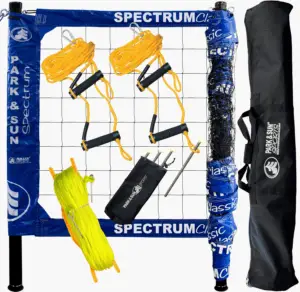
Wondering how to make a volleyball court?
Volleyball, a sport that thrives on precision and strategy, demands a well-designed court that complements the dynamism of the game. Whether you’re setting up a court for casual backyard play or organizing a competitive league, understanding the essentials of constructing a volleyball court is paramount. In this comprehensive guide, we’ll break down the steps on how to make a volleyball court, ensuring an optimal playing environment for players of all levels.
How to Make a Volleyball Court
1. Selecting the Right Location:
- Firstly, begin by choosing a level surface with ample space. The standard dimensions for a volleyball court are 60 feet in length and 30 feet in width. Initially, ensure that the area is free from obstacles, providing sufficient clearance around the court.
2. Gathering Materials and Equipment:
- Collect the necessary materials, including boundary lines, court markings, sand (for beach volleyball), and sturdy posts for net installation. For indoor volleyball, synthetic or wooden flooring may be required.

3. Measuring and Marking the Court:
- Initially, use a measuring tape and chalk or paint to mark the court’s boundaries accurately. For outdoor courts, this includes the 30×60-foot playing area, while indoor courts may require additional markings for specific zones.
4. Setting Up the Net:
- Install sturdy poles on either side of the court, ensuring they are securely anchored. The standard net height varies for men’s and women’s play, with men’s nets typically set at 7 feet 11 5/8 inches and women’s at 7 feet 4 1/8 inches. Overall, attach the net securely, ensuring proper tension.
5. Preparing the Surface:
- For beach volleyball courts, the surface is typically sand. Ensure that the sand is evenly spread and leveled, with a depth of approximately 12 inches. Firstly, tamp the sand down to create a firm but yielding surface.
- Indoor courts may use synthetic or wooden flooring. Ensure the flooring is even and has the appropriate shock absorption to minimize impact on players’ joints.
6. Marking the Serving and Attack Lines:
- Initially, use contrasting colors to mark the serving and attack lines on the court. The serving line is located 30 feet from the net, while the attack line is set 10 feet back from the net.
Tips To Research for Building a Volleyball Court
- DIY Backyard Volleyball Court: Budget-Friendly Tips and Tricks
- Firstly, explore cost-effective methods and materials for creating a volleyball court in your backyard, catering to enthusiasts with limited space and resources.
- Indoor Volleyball Court Construction: From Blueprint to Reality
- Provide insights into the nuances of constructing indoor volleyball courts, including considerations for flooring, lighting, and overall design for optimal gameplay.
- Professional Volleyball Court Builders: Choosing the Right Contractors
- Guide readers on selecting reputable contractors for more complex projects, such as building professional-grade volleyball courts. Discuss factors like experience, portfolio, and client reviews.
- Volleyball Court Maintenance: Longevity and Performance
- Finally, extend the guide to cover essential tips on maintaining a volleyball court, emphasizing regular checks, repairs, and surface upkeep for a safe and enjoyable playing experience.
Make a Volleyball Court Conclusion
In conclusion, creating a volleyball court involves more than just marking lines on the ground; it’s about crafting a space where strategy meets skill and camaraderie flourishes. Overall, whether you’re envisioning a backyard haven for weekend matches or a professional-grade court for competitive play, following these step-by-step guidelines ensures a court that not only meets regulations but also enhances the overall volleyball experience. Finally, with precision in measurements and careful planning, you can set the stage for countless rallies, spikes, and victories on your very own volleyball court.
Check out more articles found on: dennyfalls.com
Home » Volleyball » The Best Volleyball Shorts to Buy Right Now
